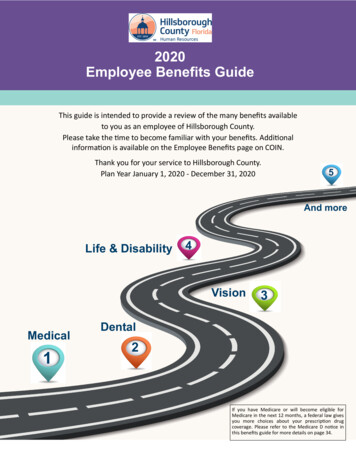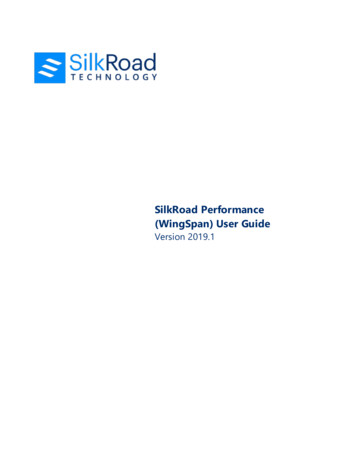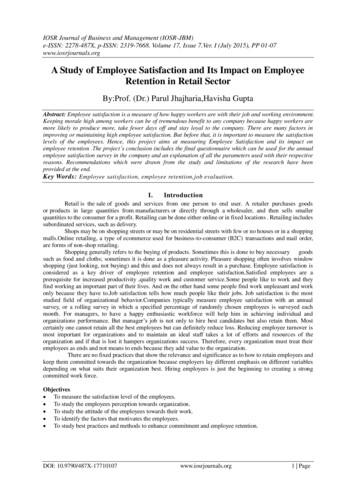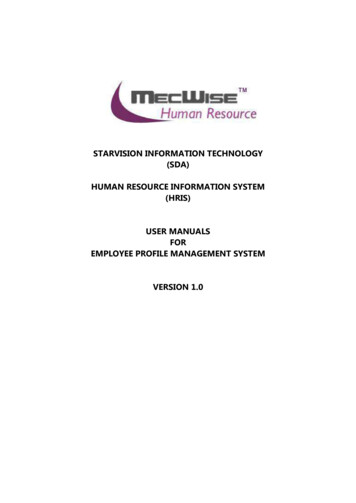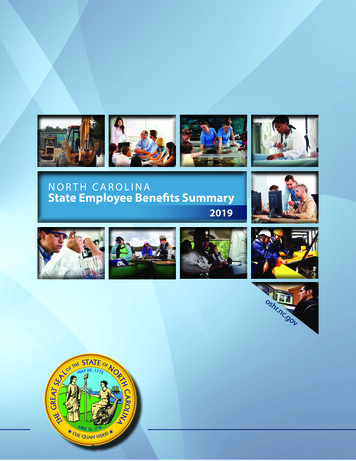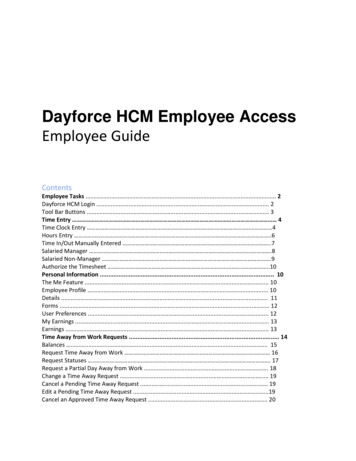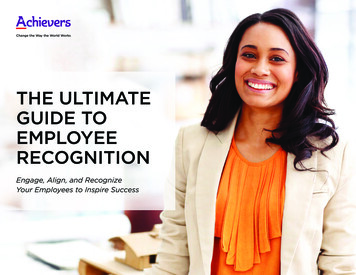
Transcription
Change the Way the World WorksTHE ULTIMATE GUIDE TO EMPLOYEE RECOGNITIONEngage, Align, and Recognize Your Employees to Inspire Success
2THE ULTIMATE GUIDE TO EMPLOYEE RECOGNITIONCONTENTS3INTRODUCTION4589PART ONE – THE CASE FOR EMPLOYEE RECOGNITIONTHE MODERN WORKFORCE AND CHANGING WORKPLACERECOGNITION CATALYZES ENGAGEMENT AND ALIGNMENTSECURING SENIOR MANAGEMENT BUY-IN1213162022PART TWO – THE HOW-TO SECTIONPLAN: CREATE YOUR OWN RECOGNITION ROAD MAPIMPLEMENT: WHAT TO KNOW FOR PROGRAM DESIGN AND ROLL-OUTBECOME A CHANGE AGENTAMPLIFY: THE SCIENCE OF REWARDS25ARE YOU READY?share this e-book!
3THE ULTIMATE GUIDE TO EMPLOYEE RECOGNITIONINTRODUCTIONTop employers are facing a perfect storm in the fight for talent. Unemploymentis at its lowest rate since 20091 and job openings have increased by 73 percent.2At the same time, Baby Boomers are rapidly retiring and new college graduatesare significantly lacking the skills businesses are seeking. And if that isn’t enough,at least one third of the existing workforce is ready to quit.3The number one reason employees quit is that they don’t receive recognition forthe work they do. Ninety percent of employers say they have some recognitionprograms in their workplaces4 but with only 13 percent of the global workforceengaged5, these programs are clearly far from effective.It’s not safe to assume your workforce is being suitably recognized, becausethe reality is that they likely are not. Their hard work is not appreciated, norvalidated in a way that evokes inspiration. It’s time to re-think recognition—the main catalyst to engaging and aligning your workforce, driving improvedbusiness performance.HOW TO READ THIS GUIDE:The Ultimate Guide to Employee Recognitionis structured in two parts:Part one reveals the case for employeerecognition, providing strong fundamentalsto support building your strategy.Part two, the how-to section, provides stepby-step tactical instructions to plan, design,execute, and communicate your strategy.Turn the page and dive in to the essentials ofemployee recognition.The knowledge and services workforces are dramatically different today.They crave a purpose-driven company, regular feedback, career opportunities,and interesting work. With 70 percent of the world’s Gross Domestic Product(GDP) generated by the knowledge and services industries6, the standardsand ideals of the workforce are shaping the way businesses operate.The Ultimate Guide to Employee Recognition will challenge conventionalthinking and help you become more future-focused, so you can respond to theneeds of today’s workforce and lead the way to employee success. You’ll learnto create a meaningful strategy from start to finish that yields higher levels ofretention, higher customer satisfaction, exceptional employee engagementand alignment, and an unmatched culture of recognition and success.share this e-book!
PART 1THE CASE FOREMPLOYEERECOGNITIONFace the changing workplace head on and buildyour case for an employee recognition strategy.
5THE ULTIMATE GUIDE TO EMPLOYEE RECOGNITIONTHE MODERN WORKFORCEAND CHANGING WORKPLACEOrganizations Now Complement Hierarchywith Cross-FunctionalityAs organizations become flatter, today’s employeeshave more opportunities to collaborate and thrive.Employees have more accountability and opportunitiesto take ownership and collaborate cross-functionally.THE EVOLUTION OF CROSS-FUNCTIONAL COMPANIES:YesterdayToday HierarchicalTop down Information on a need to know basis S tatus and rank determine control Recognition is ad hocand disconnected Authority broadly delegated Collaborative and bottom upOpen information flow S tatus and rank are not key factors Everyone recognizes eachother’s successesThe Drought of Skilled Employees Will Incite the War for TalentThe war for talent is on. Successfully recruiting and retaining top talent is a bigcompetitive differentiator. The number of available jobs is on the rise, but theUS economy will also suffer a shortfall of six million skilled workers this year.7By next year, 60 percent of new jobs will require skills held by only 20 percentof the population.8 This will impact your company and you must shift your thinkingto stay ahead of it.share this e-book!
6THE ULTIMATE GUIDE TO EMPLOYEE RECOGNITIONMillennials are Taking Over the WorkforceToday, Millennials make up about 36 percent of the workforce. By 2018, thatnumber will have increased to 50 percent.9 This generation is unique and presentsunique challenges for top employers to inspire and retain them. Constant feedback,clear communication, and collaborative work environments are key engagementdrivers for this group.201436% of the workforce are Millennials201850% of the workforce are MillennialsGEN Y IS FAST-BECOMING THE MAJORITY OF THE WORKFORCE2011: Baby Boomers225Want to learn more?Read the Class of 2014study for tips to recruitand retain Millennials.2030: Gen Xreach retirement agereaches retirement age200DOWNLOAD NOW175150MillionsAges 18-641252018: Gen Ymakes up half of theworking age population10075Pre-Boomers50Baby Boomers25Generation XGeneration Y and beyond0199019952000200520102015202020252030share this e-book!
7THE ULTIMATE GUIDE TO EMPLOYEE RECOGNITIONCustomer Centricity is the RuleToday the customer is in complete control. Companies that prioritize the customerexperience will prevail, as they generate 60 percent higher profits than theircompetitors by doing so.10 Your employees are ultimately responsible for creatingrepeat customers so you must empower them to OWN the customer experience.Adapting to the modern workforce and changing workplace is critical to long-termbusiness success. The foundation for new strategies begins with focusing on youremployees and prioritizing what needs to change based on the reality of this newtalent landscape. You’ll be set for success if you create a future-focused recognitionstrategy to engage and align employees.Companies Face New Challengesto Inspire All Employees—EspeciallyOutside the OfficeUnderstanding how to keep yourremote employees engaged, aligned,and recognized will be paramount tobusiness success. Knowledge and serviceemployees can work anywhere—evenoutside the office. Remote employeesaren’t just an extension of your team;they are your team and they expectflexibility within their work environment.Cubicles are quickly being left behindas we shift to a mobile workplace.THE MOBILE WORKPLACE1 in 5 peopleown a smart phone today 1176%of businesses saymobile devicesincreased employeeresponsivenessand decisionmaking speed 12By 2017, 90% of enterpriseapps will be both desktopand mobile, up from20% in 2013 13share this e-book!
8THE ULTIMATE GUIDE TO EMPLOYEE RECOGNITIONRECOGNITION CATALYZESENGAGEMENT AND ALIGNMENTEmployee recognition helps companiesalign employees to business objectivesby reinforcing behaviors tied to corporateresults. And it solidifies employees’emotional connection with your company,making them more engaged. Recognitionis a catalyst for engagement and alignment. These are the three ingredientsto drive remarkable business successevery single day.That’s because engaged, aligned, andrecognized employees will work harderto satisfy your customers, and in turncreate greater shareholder value.Otherwise known as the service-profitchain, employee engagement andcustomer loyalty are inextricably linked.These employees have been given thedevelopment and tools to delight thecustomer and deliver exemplary servicethat creates repeat business. Thistranslates to higher revenue growthand profitability.Strong employee alignment requiresthat all employees “get” the big picture.Only 37 percent of employees have aclear understanding of what theirorganization is trying to achieve andwhy.14 Employees need to understandhow they directly impact your businesssuccess for their jobs to feel valuable.Alignment is dependent on communicating your business objectives and corecompany values across the company.Recognizing employees for living yourcore values every day helps to connectemployees with the bigger picture andpurpose, and reinforces the right behaviorsfor your company. Make sure employeesunderstand the behaviors being measuredand why. This requires frequent andeffective communication, especially frommanagers to employees. Organizationsthat have leaders who are highly effectivecommunicators have 47 percent highertotal shareholder return.15If you reinforce desired behaviors withpositive feedback, they will be repeated.Engagement and alignment are the invaluable results of employee recognition.Recognition makes it possible to betterleverage your best resource—your people.Before digging in to define your recognitionstrategy, considering how to frame theplan for senior management will go along way to secure buy-in.share this e-book!
9THE ULTIMATE GUIDE TO EMPLOYEE RECOGNITIONSECURING SENIORMANAGEMENT BUY-INWhen senior leaders are actively involvedin employee recognition, companies arenine times more likely to have strongbusiness results.16 Everybody wins.They’re probably reluctant to admit it,but your C-level executives view youremployees as your number one cost.And they’re right. They also think inquarters, semi-annual, or annual timeframes, while employees work hourlyand daily. However, your executives willwarm up to employee recognition if youspeak the same language: using data.That will mean ROI for financial leaders,customer satisfaction for sales leaders, andengagement for HR. Provide evidence ofthe outcomes that can be achieved froma recognition strategy that engages andaligns employees.1. Present the ROI on engaged workplaces:COMPARATIVE ANNUALIZED STOCK MARKET RETURNS17(1997-2012)A recent study from a Russell Investment Groupreport identified a significant market increaseover a fifteen year period between FORTUNEMagazine’s 100 Best Companies to Work For listversus the S&P 500 and Russell 3000. FORTUNE’slist is comprised of employers that offer dreamworkplaces, and are measured on employeesatisfaction scores. There’s no denying it,Fortune 100 Best Companies perform more thantwo times better than the general market.10.8%Best Companiesperform more than2x better than thegeneral market4.5%FORTUNE 100Best Companiesto Work Forshare this e-book!S&P 500
10THE ULTIMATE GUIDE TO EMPLOYEE RECOGNITION2. Share the impact of employee engagement on financial performance:Engaged employees perform 20 percentbetter and are 87 percent less likely toleave their organizations.18And organizations with high engagementrates are 78 percent more productiveand 40 percent more profitable thanthose organizations with low levelsof engagement.19IMPACT OF EMPLOYEE ENGAGEMENT ON FINANCIAL PERFORMANCE2027.8%19.2%13.7%-11.2%-3.8%-32.7%12 month change inoperating incomeHigh employee engagement12 month net incomegrowth rateLow employee engagement12 month EPSgrowth rate3. Show how recognition has a strong impact on employees:VOLUNTARY TURNOVER2131.4% reduction involuntary turnover7.2%Excellent (5)8.7%Fair (3-4)10.5%Poor (1-2)80 percent of employees said recognition is a strongmotivator of work performance and 70 percent saidthey would work harder with continuous recognition.22Effectiveness of recognition programsat improving employee engagement.share this e-book!
11THE ULTIMATE GUIDE TO EMPLOYEE RECOGNITIONEmployee Recognition Impacts EngagementMeridian Credit UnionMeridian Credit Union, with 8 billionin assets, saw measurable, positivebusiness impact when they implementedan Achievers Employee Success Platformto engage, align, and recognize theirworkforce. The company serves morethan 260,000 customers, has 63 branchesand eight commercial business centers.The firm fully believes that the greatestleading indicator of success is employee engagement. In 2009, administrativeand management costs of running theirhomegrown recognition program weregreatly reduced by implementing theAchievers Employee Success Platform.Analyzing the impact of engagement bycomparing the top and bottom quartileof engaged employees showed that eachhighly engaged employee (top quartile)was responsible for over 2 million ingrowth, while each of the least engagedemployee (bottom quartile) were responsible for 1.29 million. The most engagedemployee was solely responsible for a4.7 percent increase in the company’sclient-base, while the least engagedemployee was responsible for just over1 percent. Meridian’s operating marginsincreased over 10 percent for employeeswithin the top quartile of engagement.On the other hand, the bottom quartile ofengaged employees caused -1.2 percentin operating margin growth.Engaged employees were the key driversof success for Meridian’s improved financialresults. Their recognition program wasresponsible for driving the behaviors thatcreated better alignment and improvedbusiness performance. Companies likeMeridian benefit from one consolidatedEmployee Success Platform to improveengagement, alignment and recognition.Your Next MoveAn employee recognition strategy that has buy-in from senior leaders can transformyour company by creating a culture of recognition that promotes strong engagementand alignment—every day. You’ll build your reputation as a top employer and attractthe best talent. So what should you do next? Make your case. The investment youhave today in recognition or rewards can be better spent and deliver more impactand ROI. Gather relevant information about your company and ask questions.Survey employees to determine whether you have low or average engagementscores. Present the findings to your executives and show them you can reduceyour company’s costs and have a positive impact on the results that matter most,revealing the ROI of employee recognition.share this e-book!
PART 2THE HOW-TOSECTIONLearn to plan, design, communicate, and roll-outyour employee recognition strategy.
13THE ULTIMATE GUIDE TO EMPLOYEE RECOGNITIONPLAN: CREATE YOUR OWNRECOGNITION ROAD MAPLearn to plan, design, communicate, and roll-out your employee recognition strategy.Modern recognition strategies are necessary to win in today’s competitive business environment. Old-school strategies miss thepoint about engagement, alignment, and recognition, and can actively disengage employees with untimely and meaninglessrewards. Avoid the pitfalls of old-school programs by creating a modern recognition strategy that engages, aligns, and recognizesyour employees. A consolidated program provides valuable insight and eliminates manual processes for tracking results.Your winning strategy must be transparent and advanced—just like the modern workplace. Here it is: your step-by-step how-toguide to replace dated programs and make significant business impact. It’s ultimately up to you, so what are you waiting for?PricewaterhouseCoopers’ 2013 CEO Survey included a quote from Jean-Pascal Tricoire,president and CEO of Schneider Electric SA, France. He said, “People need a senseof purpose. Gross margins are not the stuff of which dreams are made. And evenwithout going so far as to talk of dreams, you cannot inspire people to take action,create, or motivate without instilling a sense of purpose, especially when times aredifficult.”23 Even in the face of global economic turbulence, companies with anengaged, aligned, and recognized workforce can succeed. And yours can, too.Employee recognition is the spark that gets it all going.It fulfills our intrinsic need to achieve and motivates us because of our inherentdesire for acceptance and belonging. Recognition provides the avenue for purposeto be infused into daily actions. It provides perspective as recognition shows thereceiver how their work connects with all levels of the bigger picture—how it impactsthe people around you, the department, the company, the purpose of the organization.Recognition infuses everything with energy.“People need a sense ofpurpose. Gross margins arenot the stuff of which dreamsare made. And even withoutgoing so far as to talk of dreams,you cannot inspire people totake action, create, or motivatewithout instilling a sense ofpurpose, especially whentimes are difficult.”The next section will help you implement an inspiring recognition strategy thatengages and aligns your employees.share this e-book!
14THE ULTIMATE GUIDE TO EMPLOYEE RECOGNITIONFive Steps to Charting Your Road Map1Determine Your Company’s Starting PointBefore you can cross the finish line, you must understand where to begin. Before planning changes, investigate the current stateby answering, “What does our current employee recognition, engagement, or alignment strategy look like?” With a completepicture of what is in place today, determine industry best practices and benchmarks, which will help you better visualize thedirection you need to go.Best practice: Undertake an employee engagement survey to obtain real up-to-date data and use the insights to guide your nextsteps. Then, conduct focus groups with employees and managers and ask for feedback about survey results.23Ensure Your Strategy is Mobile-FirstEnable Managers with the Purpose Behind RecognitionAccording to Gartner, there are moreconnected mobile devices on earth thanthere are people. The workforce is nowmore mobile than ever before. Gartneralso expects 80 percent of businessesto support employees who use tabletsby 2014.24 Employees can work anywherein the world. Mobile technology canhelp you create and sustain a culture ofrecognition, even for offline employees.Explain to managers the “why” behind recognition. For example, recognition couldbe used to align globally dispersed employees or inspire better teamwork andproductivity. Recognition helps employees rise to the occasion and go aboveand beyond. Help managers understand why it’s paramount to your business.Most importantly, separate general compensation and recognition (compensationis only part of employees’ basic needs).Best practice: Build a culture of recognitionfor your offline and geographically dispersedworkforce with a mobile-first strategy.Best practice: Determine the reason for employeerecognition, such as “aligning all employees to businessobjectives” for example, then communicate it toyour team.Take the next step: Read TheSecret Weapon to DrivingEmployee Success to empoweryour managers to build a cultureof recognition.DOWNLOAD E-BOOKshare this e-book!
15THE ULTIMATE GUIDE TO EMPLOYEE RECOGNITION45Align Business Objectives and CorporateValues with RecognitionConsider how Recognition Impacts the Employee Life CycleNot only does recognition reinforceexemplary behavior, but you canutilize a platform to align employeesto business objectives and companyvalues with recognition.Best practice: Determine your end goals.Are they increased employee engagementor retention? Or are they aligning oneglobal culture?Talent management is multi-faceted and requires multiple systems and processes.An employee recognition strategy must work in harmony with all aspects of theemployee life cycle.Best practice: It’s best to implement a tool that seamlessly integrates with allyour HR systems. Opportunity to leverage recognition exists at every phase ofthe employee life cycle. See chart below for more.EMPLOYEE LIFE CYCLEAttractionRecruitmentOnboardingDevelopment& PerformanceRetention E mployee ValueProposition (EVP) B est EmployerStatus Referrals/Sourcing Social Technology Orientation L MS supportedonboarding B enefits (Wellness& Safety Programs) M anagingPerformance,Coaching, Feedback LeadershipDevelopment Sales Incentives Engagement L eader and Managereffectiveness S uccession/Growthplans Career discussionsSeparation Exit Interviewsshare this e-book!
16THE ULTIMATE GUIDE TO EMPLOYEE RECOGNITIONIMPLEMENTATION: WHAT TO KNOWFOR PROGRAM DESIGN AND ROLL-OUT10 Critical Success Factors for Designing Workforce RecognitionThis list includes the core elements you will need to consider to design a stellarprogram. We’ve done the research so you can focus on what’s most important.1BudgetCompanies typically spend as much as1 - 2 percent of payroll on recognitionprograms, although most focus onrewarding tenure.25 It’s important toallocate the appropriate budget forrecognition programs that fosterfrequent recognition, making it a dailyhabit. View this spend not as a cost,but more as an investment in yournumber one asset.2FrequencyAlign recognition frequency withall other aspects of your strategy.Only 22 percent of employees reportthat they are recognized regularly.26Therefore, recognition must be frequent.The best part? Recognition can actuallyoccur continuously and not cost a penny.It’s free.Decide how much you will spend,and how you will tie performancegoals to the right behaviors in orderto demonstrate an ROI. Your executiveswill require updates AND data not onlyto create your program but keep itrunning long term.share this e-book!
3CriteriaDetermine the behaviors that alignwith business objectives and corporatevalues. Outlining proper behaviors thatare aligned to company values helpsgive your program more structure andcredibility and enables recognition topowerfully drive success.Communicate recognition criteria withyour entire organization so employeesunderstand why desired behaviors arealigned with company values.4Recognition for One and AllEveryone in your organization must usethe recognition program if it will havea lasting impact. Recognition can andshould happen anywhere, at any time,on any mobile or desktop device.Create a program that encourages allemployees to recognize each otherregardless of physical location or title.5Peer-to-peer RecognitionRemember, even the most competitiveorganizations are becoming far morecollaborative and transitioning awayfrom traditional top-down hierarchies.To create a cross-functional culture ofrecognition, you’ll need to enable peerto-peer recognition.Enable peer-to-peer recognition tospark participation at all levels of theorganization; otherwise you won’t seethe results.7VisibilityThere are three types of recognition:public, group, and private. Often, makingemployee recognition visible to the entireorganization is an important consideration.Visible recognition can occur in thefollowing ways:6No Barriers to RecognitionCompetitive organizations eliminate any approval processes for recognition andimplicitly trust their employees who participate. This is more empowering for theemployee. Recognition should be organic and seamless.Recognition provides employees with unsolicited, positive feedback, so make sure toeliminate any barriers or approval processes for employees to recognize.Public: Online newsfeedGroup: In front of the employee’s teamPrivate: Employee/manager one-on-oneConsider making employee recognitionvisible to your entire organization, as itwill help reinforce the right behaviorsand provide ongoing participationmomentum as employees can see thesuccesses recognized and shared bytheir colleagues.share this e-book!
188THE ULTIMATE GUIDE TO EMPLOYEE RECOGNITIONDeliveryYou know the value of receiving something thoughtful. Excellent deliverywill help your employees feel valued.Recognition can be delivered face-toface, in a letter or email, at an event, oronline. Evaluate the standard template orformat for recognitions—it should look asgood as the message being delivered.With global workforces, personalizedand meaningful electronic recognitionis the way to go.9ConsistencyA consistent employee experience foryour entire workforce must includeengagement and alignment soemployees feel connected to a unifiedculture and experience. Within acompany-wide recognition programconsider including different programfeatures that reflect the specific needsof each locale while ensuring theoverarching program is consistent.10MeasurementCarefully consider what success looks likeand how you’ll measure it. You must beable to demonstrate the impact of yourprogram on your employees (improvedengagement, retention, etc.) and onbusiness performance.Offer a unified employee experience, evenif some parts of your program need to becustomized to meet global requirements.Did you know that a consolidatedEmployee Success Platform largelyeliminates the burden of administration?See how Save Mart Supermarkets implementedthe Achievers Employee Success PlatformTM toachieve better business results.You’ll benefit from automatic reportingbased on predetermined criteria.Also, you’ll be able to get a clearpicture of employee performanceand how well employees are alignedto business objectives.share this e-book!
Jump-Start Your RecognitionCulture with an Exciting andEngaging LaunchThe way you roll-out your program isjust as important as the design process.Employees should feel energized aboutyour new recognition program and inspired to use it. That’s why we’ve puttogether a cheat-sheet with some bestpractices for your program launch.Spread the Word with Clear CommunicationAfter you’ve determined your objectives, incorporate them into a communications plan and marketing collateral. Best-in-classcommunication efforts begin during the design phase, so get key stakeholders involved early.Create marketing materials to communicate program goals and recognition best practices. Be sure they are aligned with your brandvoice and guidelines to provide one consistent message across your organization.Most importantly, have fun with it and get creative. This is a great opportunity to think outside the box to get employees’ attention.Equip Employees (and Managers, Especially) with TrainingWhen you actually launch the programspecial training is required for the programadministrators in your organization. Setthem up for success by coaching them onrecognition best practices, the power ofengagement and alignment, how to usethe program, and how to effectively usedashboards and reporting tools.But don’t forget about managers.Too often managers are trained on thehow, but not the why. If you can helpmanagers understand the “What’s InIt For Me” they’ll jump on boardwithout hesitation.Don’t simply train on process andtechnology. Everyone must understandthe “why” and see the connection tobusiness success.Equip managers with training today: ReadThe Secret Weapon to Driving EmployeeSuccess to provide them with coachingand recognition best practices.DOWNLOAD NOWshare this e-book!
20THE ULTIMATE GUIDE TO EMPLOYEE RECOGNITIONBECOME A CHANGE AGENTImplementing change is never simple but you can minimize the pain. This sectionbreaks down the basics to help you become an agent of change.Remove the Burden of Manual Administration with ConsolidationThe way you administer your program will impact its success. Most companies’programs tend to operate in isolation from other HR systems. It’s important toconsolidate your program into one integrated platform that will scale across yourbusiness. There must be harmony.Front-line employees only need to go to one place, managers get the employeevisibility they need, and the company has cost control and reporting to understandwhere to invest its dollars.Communicate, Communicate, CommunicateTake considerate measures and communicate the changes to your organization.Program adoption is critical to create a culture of recognition. Communicate thebenefits of your recognition program to all employees early and often.share this e-book!
21THE ULTIMATE GUIDE TO EMPLOYEE RECOGNITIONConstantly Assess the Program’s ValueYour recognition program and your company’s values should be aligned.As business goals change, so might your program. You must keep the bigpicture in mind. How do changes impact the ways in which employeesrecognize one another?Communicate all program changes to employees, especially if goals orrecognition criteria change.Optimize Programs to Keep Them FreshOver time, re-examine your program to ensure that it’s meeting yourorganization’s goals. Solicit feedback from key stakeholders. You shouldconstantly think about ways to update your program, keeping it freshand dynamic.Assess whether certain metrics or criteria are getting the results you want,and if not, continue refreshing until you’re satisfied.share this e-book!
22THE ULTIMATE GUIDE TO EMPLOYEE RECOGNITIONAMPLIFY: THE SCIENCE OF REWARDSPeople like to group rewards and recognition together as though they are one.Rewards can complement recognition but are not a replacement. It’s not aboutonly giving employees things.You have a chance to amplify recognition, engagement, and alignment withrewards, done the right way. A paycheck is not a thank you, as it only satisfiesyour employees’ basic needs. You want to reinforce the right employee behaviors,and then reward them accordingly.If recognition fulfills our intrinsic needs for love, belonging, and self-esteem,then rewards act as an extrinsic motivator. When you receive a reward that youchoose, it is more meaningful and you’ll associate it with positive memories tiedto your company.share this e-book!
23THE ULTIMATE GUIDE TO EMPLOYEE RECOGNITIONWhy Rewards are Critical to Recognition ProgramsRECOGNITION ELEMENTS AND THE RELATIONSHIPS WITH TOP-QUARTILE BPI OUTCOMES27Monetary RewardsPraise and Emblematic RewardsRecognition ElementsBersin by Deloitte’s research identified twodifferent types of recognition: praise andemblematic recognition, and token and monetaryrewards. In this study, they found that both typesof recognition are important to employees, as thisvaried approach helps to constantly and frequentlyreinforce desired employee behaviors. Althoughdifferent types of recognition are important itshould always be aligned with your organization’svalues and business objectives.If highly effective at therecognition approach,liklihood of being intop quartile of businessperformance index ive public recognition, withGno monetary value (e.g. public“thank yous”, certificates, trophies,plaques, etc.) Provide paid days off2.8 ive public recognition, withGmonetary value (e.g. companywideawards) Allow employees to nominate eachother for companywide awards(with monetary value)3.
share this e-book 2 the ltimate gide to employee recognition contents 3 introduction 4 part one – the case for employee recognition 5 the modern workforce and changing workplace 8 recognition catalyzes engagement and alignment 9 securing senior management buy-in 12 part two – the how-to section 13 plan: create your own


